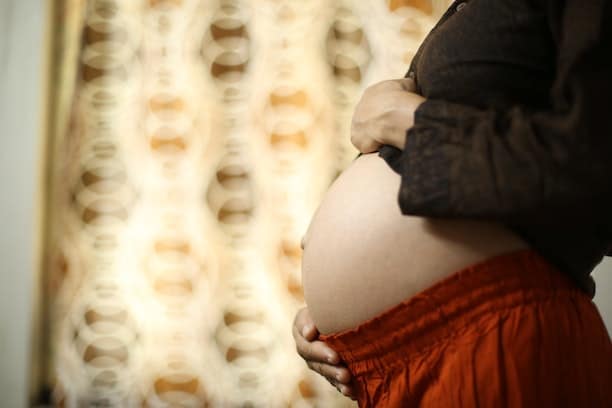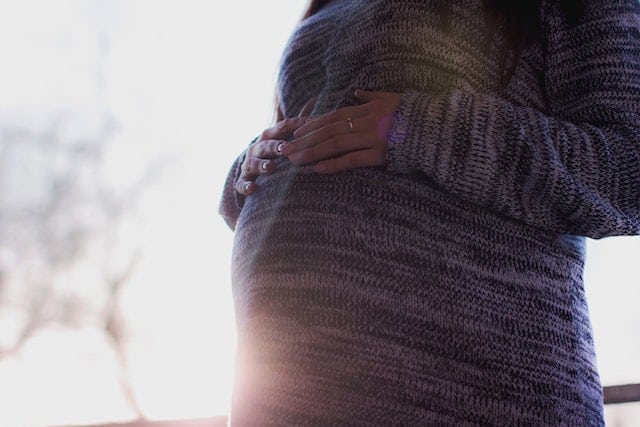Pregnancy is an exciting time for expecting mothers, but it can also be a confusing time with many changes happening to the body. One of the most noticeable changes is the growth of the belly as the baby develops.
However, some women may experience a smaller-looking belly during the final stretch of their pregnancy, causing concern and confusion.
There are several reasons why a 9 months pregnant belly might look smaller than expected. One of the most common reasons is the baby’s position in the womb.
If the baby is positioned towards the back or towards the spine, it can make the belly look smaller from the front. Additionally, if the baby has dropped lower into the pelvis in preparation for birth, it can also cause the belly to appear smaller.
Key Takeaways
- A smaller-looking belly during the final stretch of pregnancy is not necessarily a cause for concern.
- The baby’s position in the womb can impact the size and appearance of the belly.
- Regular check-ups and ultrasounds can help ensure the baby’s health and development.
Understanding Pregnancy and the 9 Months Journey
Pregnancy is an incredible journey that lasts for approximately 9 months. This journey is divided into three trimesters, each lasting for about 3 months.
During this period, the body undergoes significant changes as it prepares to bring a new life into the world.
The first trimester is the initial stage of pregnancy, and it begins with conception. During this period, the body starts to produce hormones that are necessary for the growth and development of the fetus.
The first trimester is also the time when many women experience morning sickness, fatigue, and mood swings.
The second trimester is the middle stage of pregnancy, and it is often considered the easiest. During this period, the body has adapted to the changes that come with pregnancy, and most women feel more comfortable.
The second trimester is also the time when the baby’s movements become more noticeable.
The third trimester is the final stage of pregnancy, and it is the time when the baby grows the most. During this period, the baby’s organs mature, and the body prepares for delivery.
Many women experience discomfort during the third trimester, such as back pain, swelling, and difficulty sleeping.
It is important to note that every pregnancy is different, and the size of the belly can vary from woman to woman. While some women may have a large belly during pregnancy, others may have a smaller belly.
The size of the belly does not necessarily indicate the health of the baby or the mother.
In conclusion, pregnancy is a unique journey that lasts for approximately 9 months and is divided into three trimesters. Each trimester has its own set of changes and challenges, and it is important for women to take care of themselves during this period.
While the size of the belly can vary from woman to woman, it does not necessarily indicate the health of the baby or the mother.
The Pregnant Belly: Normal Growth and Changes
During pregnancy, a woman’s body undergoes numerous changes, including the growth and expansion of the uterus to accommodate the developing fetus.
As a result, the size and shape of the pregnant belly change throughout the course of the pregnancy.
In the early stages of pregnancy, the uterus is still small, and the belly may not show any visible signs of pregnancy. However, as the uterus grows, the belly begins to protrude, and the woman may develop a noticeable baby bump.
As the pregnancy progresses, the belly continues to grow, and the uterus expands to accommodate the growing fetus. The abdominal muscles and stomach also stretch to make room for the baby, and the skin of the belly may become stretched and thin.
In the later stages of pregnancy, the belly may take on a rounder, more pronounced shape as the baby grows and the uterus expands further. The belly may also become lumpier in appearance as the baby moves around and changes position within the uterus.
It is important to note that every woman’s pregnancy is different, and the size and shape of the pregnant belly can vary widely.
Factors such as the size and position of the baby, the woman’s body type, and the strength of her core muscles can all affect the appearance of the belly during pregnancy.
Overall, changes in the size and shape of the pregnant belly are a normal part of pregnancy, and women should not be concerned if their belly appears smaller or larger than expected at any point during their pregnancy.
Why a 9 Months Pregnant Belly Might Look Smaller
When a woman is 9 months pregnant, it is expected that her belly will be quite large due to the growing baby inside. However, in some cases, the belly might appear smaller than expected. There are several reasons why this might happen.
Firstly, it is important to note that every woman’s body is different and there is a wide range of what is considered “normal” during pregnancy.
Some women might naturally have a smaller build or be more petite, which can make their belly appear smaller even when they are 9 months pregnant.
Secondly, it is possible for a woman’s belly to shrink slightly towards the end of pregnancy. This can happen due to a variety of reasons, such as the baby dropping lower into the pelvis or the amniotic fluid levels decreasing.
However, it is important to note that significant shrinkage or sudden changes in belly size should be discussed with a healthcare provider to ensure the health of both the mother and baby.
Lastly, it is important to prioritize maternal health during pregnancy. If a woman is experiencing health complications or is not gaining enough weight during pregnancy, it is possible for her belly to appear smaller.
In these cases, it is important for the woman to work closely with her healthcare provider to ensure the health and safety of both herself and the baby.
In conclusion, a 9 months pregnant belly might look smaller due to a variety of reasons, including natural body size, shrinkage towards the end of pregnancy, and maternal health concerns.
It is important for women to prioritize their health during pregnancy and to discuss any concerns with their healthcare provider.
Impact of Baby’s Position on Belly Size
The position of the baby in the womb can have a significant impact on the size of the pregnant belly. As the baby grows and develops, he or she may shift and move around, causing the belly to change shape and size.
When the baby is in the head-down position, with his or her head facing the pelvis, the pregnant belly may appear smaller. This is because the baby’s head is tucked down low in the pelvis, putting pressure on the pubic bone and causing the belly to flatten out.
On the other hand, when the baby is in a transverse position, lying sideways in the womb, the pregnant belly may appear larger. This is because the baby’s body is stretching out across the width of the belly, causing it to bulge outwards.
In some cases, the baby may be in a breech position, with his or her feet or buttocks facing down towards the pelvis. This can also cause the pregnant belly to appear larger, as the baby’s body is positioned in a way that puts pressure on the top of the uterus.
Overall, the position of the baby in the womb can have a significant impact on the size and shape of the pregnant belly. It is important for expectant mothers to be aware of their baby’s position and to talk to their healthcare provider if they have any concerns about their pregnancy.
Twins and Belly Size
When it comes to twin pregnancies, there is no doubt that the belly size will be larger than that of a singleton pregnancy. However, it is important to note that each pregnancy is unique, and the size of the belly can vary from woman to woman.
In some cases, a woman carrying twins may have a smaller belly size than expected. This can be due to a number of factors, such as the position of the babies, the amount of amniotic fluid, and the mother’s body type.
It is also worth noting that a smaller belly size does not necessarily mean that the babies are not growing properly. Regular ultrasounds and check-ups with a healthcare provider can help ensure that the babies are developing as they should be.
Overall, while a larger belly size is expected with twin pregnancies, a smaller belly size is not necessarily a cause for concern.
It is important for women carrying twins to have regular check-ups with their healthcare provider to ensure that both babies are growing and developing properly.
Importance of Regular Check-ups and Ultrasounds
Regular prenatal appointments and ultrasounds are crucial during pregnancy to ensure the health and well-being of both the mother and the baby.
One of the important measurements taken during these appointments is the fundal height, which is the distance between the top of the pubic bone and the top of the uterus. This measurement helps to estimate the growth of the baby and detect any potential issues.
Ultrasounds are also important for monitoring the growth and development of the baby. They can detect any abnormalities or complications, such as low amniotic fluid or placenta previa. Additionally, ultrasounds can help determine the due date and the position of the baby.
Regular check-ups with a doctor or midwife can also help detect any potential health issues in the mother, such as gestational diabetes or high blood pressure.
These conditions can be managed with proper care and monitoring, but if left untreated, they can lead to complications for both the mother and the baby.
In conclusion, regular prenatal appointments and ultrasounds are essential for monitoring the health and development of both the mother and the baby. It is important to attend all scheduled appointments and communicate any concerns or issues with the healthcare provider.
Diet and Lifestyle Factors Affecting Belly Size
The size of a pregnant belly can be affected by various diet and lifestyle factors.
Here are some of the key factors that can contribute to a smaller-looking belly:
Eating Habits
Eating a healthy and balanced diet throughout pregnancy can help keep the belly size in check. Consuming foods that are high in fiber, protein, and healthy fats can help prevent excessive weight gain and bloating.
On the other hand, consuming foods that are high in sugar, salt, and unhealthy fats can cause water retention and bloating, which can make the belly appear larger than it actually is.
Weight Gain
Gaining too much weight during pregnancy can cause the belly to appear larger than it actually is. This is because excess weight gain can cause the body to store more fat, particularly around the belly area.
On the other hand, gaining too little weight can also cause the belly to appear smaller than it actually is.
Exercise
Regular exercise during pregnancy can help maintain a healthy weight and prevent excessive weight gain. Exercise can also help tone the muscles in the abdomen, which can help support the growing uterus and prevent the belly from appearing too large or too small.
Water Weight
Water retention is common during pregnancy and can cause the belly to appear larger than it actually is. Drinking plenty of water and avoiding salty foods can help prevent water retention and reduce bloating.
Bloating
Bloating is another common issue during pregnancy that can cause the belly to appear larger than it actually is.
Eating small, frequent meals and avoiding foods that are known to cause bloating, such as beans, cabbage, and onions, can help reduce bloating and prevent the belly from appearing too large.
Preparing for Labor and Delivery
As the due date approaches, it’s important to prepare for labor and delivery. Here are a few things to keep in mind:
Hospital Preparations
Make sure you know the location of the hospital you plan to deliver at and have a plan for getting there. Pack a bag with essentials for you and your baby, such as clothes, toiletries, and diapers.
It’s also a good idea to have a list of important phone numbers, including your doctor’s office and emergency contacts.
Signs of Labor
Knowing the signs of labor can help you prepare for the big day. Common signs include contractions, back pain, and a “bloody show” (a small amount of blood or mucus discharge). If you experience any of these symptoms, contact your doctor or midwife.
Baby Dropping
In the weeks leading up to delivery, your baby may “drop” lower into your pelvis. This can cause increased pressure and discomfort, but it also means that labor may be approaching. Keep an eye out for other signs of labor if you notice your baby dropping.
Birth Canal
The birth canal is the pathway through which your baby will pass during delivery. It’s important to keep this area clean and healthy to reduce the risk of infection. Your doctor or midwife can provide guidance on how to do this.
Delivery
When it’s time to deliver, your doctor or midwife will guide you through the process. It’s important to stay calm and follow their instructions. Remember that every delivery is different, and there’s no “right” way to do it.
Overall, preparing for labor and delivery can help reduce stress and anxiety as the due date approaches. Keep in touch with your doctor or midwife and follow their advice to ensure a safe and healthy delivery.
Post-Pregnancy Belly Changes
After giving birth, many women notice changes in their belly size and shape. While some may experience a significant reduction in belly size immediately, others may take longer to see changes. Here are some common post-pregnancy belly changes that women may experience:
Belly Size
For many women, their belly size may appear smaller after giving birth. This is due to the uterus shrinking back to its pre-pregnancy size and the loss of excess fluid and blood.
However, some women may still have a noticeable belly bump for several weeks or months after giving birth.
Belly Shape
The shape of the belly may also change after giving birth. The abdominal muscles may have separated during pregnancy, resulting in a condition called diastasis recti. This can cause the belly to protrude even after giving birth.
In some cases, the muscles may heal on their own, while others may require physical therapy or surgery.
First-Time Moms vs. Second Pregnancy
First-time moms may notice more significant changes in their belly size and shape after giving birth, as their abdominal muscles have not been stretched before.
However, women who have had multiple pregnancies may have a harder time getting their belly back to its pre-pregnancy size and shape.
Maternity Clothes
After giving birth, women may need to continue wearing maternity clothes for some time, as their regular clothes may not fit comfortably yet. Maternity clothes can provide support for the belly and help women feel more comfortable during the postpartum period.
Overall, post-pregnancy belly changes can vary from woman to woman. It’s important to be patient and give your body time to heal after giving birth. If you have concerns about your belly size or shape, speak with your healthcare provider.
Addressing Common Concerns and Misconceptions
As a woman approaches the end of her pregnancy, it’s not uncommon for her to feel like her belly has suddenly shrunk. This can be a source of concern for many expectant mothers, but there are several reasons why this might happen.
Lightening
One common reason why a pregnant belly might appear smaller is due to a phenomenon known as “lightening.” This occurs when the baby drops down into the pelvis in preparation for birth. As a result, the baby’s head puts pressure on the cervix, which can cause the belly to appear smaller.
Braxton-Hicks Contractions
Another reason why a pregnant belly might appear smaller is due to Braxton-Hicks contractions. These are practice contractions that occur in preparation for labor. They can cause the belly to tighten and feel smaller.
Discomfort
As a woman approaches the end of her pregnancy, she may experience discomfort due to the size of her belly. This can make it feel like her belly has suddenly shrunk, when in reality, it’s just that she’s not as uncomfortable as she was before.
Medical Advice
If a woman is concerned about the size of her belly, she should speak with her healthcare provider. They can provide medical advice and help determine if there is a cause for concern.
Morning Sickness
Morning sickness can also impact the size of a pregnant belly. If a woman is experiencing severe morning sickness, she may not be able to eat as much as she needs to, which can cause her belly to appear smaller.
Constipation
Constipation is another common issue that can impact the size of a pregnant belly. If a woman is constipated, she may feel bloated and uncomfortable, which can make her belly appear larger than it actually is.
Pee
Finally, a full bladder can also impact the size of a pregnant belly. If a woman needs to pee, her bladder can push against her uterus, making her belly appear larger.
In conclusion, there are several reasons why a pregnant belly might appear smaller. It’s important for women to speak with their healthcare provider if they have any concerns or questions about the size of their belly.
Baby’s Development and Care
As the due date approaches, the baby’s development and care become a top priority for expecting parents. At 9 months pregnant, the baby is fully developed and ready to make its grand entrance into the world.
Fetal Development
At this stage, the baby weighs around 6-9 pounds and measures around 18-20 inches in length. The lungs are fully developed, and the baby is practicing breathing movements. The baby’s brain is also fully developed, and the nervous system is functioning correctly.
Infant CPR
It is essential to learn infant CPR before the baby arrives. CPR can help save a baby’s life in case of an emergency. Parents can take classes in infant CPR to learn how to perform it correctly.
Feeding
Feeding is an essential aspect of the baby’s care. Breastfeeding is recommended for the first six months of the baby’s life. However, if breastfeeding is not possible, formula feeding is a good alternative. Parents should consult with their doctor to determine the best feeding method for their baby.
Baby Products
Parents need to have the necessary baby products ready before the baby arrives. These include a crib, stroller, car seat, diapers, and wipes. It is also recommended to have a baby registry builder to ensure that parents receive the necessary items.
First Year and Toddler
The first year of the baby’s life is full of milestones, including crawling, walking, and talking. Parents should consult with their pediatrician to ensure that their baby is meeting these milestones.
As the baby enters the toddler stage, parents should continue to provide a safe and nurturing environment while encouraging their child’s development.
In conclusion, at 9 months pregnant, the baby’s development and care become a top priority for expecting parents.
Parents should be knowledgeable about the baby’s development, learn infant CPR, determine the best feeding method, have the necessary baby products, and continue to provide a safe and nurturing environment for the baby’s first year and toddler stage.
Community and Family Support
During pregnancy, it is important for the expecting mother to have a strong support system. This can come from family, friends, and even the wider community.
Having a supportive network can help alleviate stress and anxiety, which can have a positive impact on both the mother and the developing baby.
Family support is especially crucial during pregnancy. Partners, parents, and siblings can provide emotional support, help with household chores, and even assist with childcare for any other children in the family.
This can be especially helpful in the later stages of pregnancy when the mother may experience physical limitations.
Community support can also be beneficial during pregnancy. Local groups and organizations can provide resources and information on prenatal care, breastfeeding, and other topics related to pregnancy and childbirth. These groups can also provide a sense of community and belonging for expecting mothers.
News and media outlets can also play a role in supporting pregnant women. They can provide accurate and helpful information on pregnancy and childbirth, as well as highlight stories of women who have successfully navigated pregnancy and motherhood.
This can help to normalize the experience of pregnancy and reduce any feelings of isolation or anxiety.
Finally, fertility clinics and specialists can provide support for women who have struggled with fertility. They can offer counseling, medical interventions, and other resources to help women achieve a healthy pregnancy.
This can be especially important for women who have experienced miscarriage or other challenges in their journey to becoming pregnant.
Overall, community and family support can be a valuable resource for pregnant women. By providing emotional and practical support, these entities can help to ensure a healthy and positive pregnancy experience.
Frequently Asked Questions
Can your pregnant belly get smaller before labor?
Yes, it is possible for a pregnant belly to appear smaller before labor. This is because the baby may have dropped lower into the pelvis, causing the belly to shift downwards and appear smaller.
Is it normal for your belly to shrink at the end of pregnancy?
Yes, it is normal for a pregnant belly to shrink at the end of pregnancy. This is because the baby may have dropped lower into the pelvis, causing the belly to shift downwards and appear smaller. Additionally, the body may begin to shed excess fluid, which can also contribute to a smaller belly.
Why is my pregnant belly getting smaller?
There are several reasons why a pregnant belly may appear smaller. As previously mentioned, the baby may have dropped lower into the pelvis, causing the belly to shift downwards. Additionally, the body may begin to shed excess fluid, which can also contribute to a smaller belly.
However, if you are concerned about your belly size, it is important to speak with your healthcare provider.
Why is my pregnant belly soft at the bottom?
A soft belly at the bottom during pregnancy is normal and can be attributed to the growing uterus. As the uterus expands to accommodate the growing baby, it pushes against the abdominal wall, causing the area to feel soft.
How to avoid big belly during pregnancy?
It is not possible to completely avoid a big belly during pregnancy, as the growing baby and uterus will naturally cause the belly to expand. However, maintaining a healthy diet and exercise routine can help to keep weight gain in check and promote a healthy pregnancy.
6 months pregnant belly still small?
It is normal for a 6-month pregnant belly to appear small, as the baby is still growing and developing. However, if you are concerned about your belly size, it is important to speak with your healthcare provider to ensure that everything is progressing as it should be.
Related Posts:
- 10 Weeks Pregnant No Symptoms Anymore
- 13 Weeks Pregnant Belly Still Soft
- Baby’s Face Looks Weird On Ultrasound

Nazeli Gevorgyan studied at Yerevan State Medical University and is an Obstetrics/Gynecology resident



